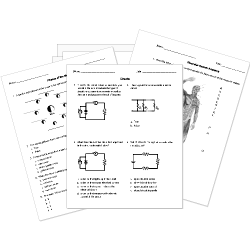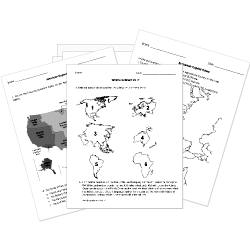Introduction to Nuclear Processes
Introduction to Nuclear Processes
This lesson aligns with NGSS PS1.C
Introduction
A naturally occurring nuclear reaction is a result of the interaction between cosmic rays and matter. Conversely, artificially induced nuclear reactions are employed to obtain nuclear energy in a controlled and adjustable manner. One of the most significant types of nuclear reactions is the nuclear chain reaction, specifically involving fissionable materials that undergo induced nuclear fission. These reactions play a crucial role in energy production, while various nuclear fusion reactions of light elements power the energy production of the Sun and stars. In this article, we will explore the concept of nuclear process as well as the other important terms used in nuclear processes.
Nuclear processes
At the core of every atom lies the nucleus, an incredibly powerful region where protons and neutrons reside. The behavior of this nucleus is governed by nuclear processes, which can be broadly classified into nuclear fusion, nuclear fission, and radioactive decay.
Nuclear Fission
Nuclear fission involves the splitting of a heavy atomic nucleus into two or more lighter nuclei, releasing a significant amount of energy. Simultaneously, the process involves the emission of neutrons and gamma rays, specifically photons carrying significant energy capable of displacing electrons from atoms.
The concept of nuclear fission was originally proposed by German chemists Otto Hahn and Fritz Strassmann.

Key Terms:
Chain Reaction:
A self-sustaining series of nuclear fission reactions initiated by the release of neutrons from previous fission events.
Critical Mass:
The minimum amount of fissile material required to sustain a chain reaction.
Applications:
Nuclear fission is the basis for nuclear power generation in reactors, where controlled fission reactions produce heat that is converted into electricity.
The energy generated from fission reactions serves as a source for electricity production, particularly in nuclear power plants. The heat generated during the nuclear reaction is utilized to convert water into steam. Subsequently, this steam is employed to rotate turbines, ultimately generating electricity.
Nuclear Fusion:
Nuclear fusion is a process in which two light atomic nuclei combine to form a heavier nucleus, accompanied by the release of a substantial amount of energy. Subatomic particles e.g. neutrons or protons are formed as products of these nuclear reactions.

Key Terms:
Stellar Nucleosynthesis:
The process by which stars generate energy through nuclear fusion, particularly the conversion of hydrogen into helium.
Thermonuclear Reaction:
A fusion reaction that occurs at high temperatures, typically found in stars or artificially created in experimental fusion reactors.
Applications:
Nuclear fusion powers the sun and other stars. Efforts are underway to replicate controlled fusion on Earth for clean and sustainable energy production.
Radioactive Decay:
Radioactive decay is a natural process in which unstable atomic nuclei transform into more stable configurations, emitting radiation in the process.

Key Terms:
Half-life (t1/2):
The time required for half of a sample of radioactive material to undergo decay.
Alpha, Beta, and Gamma Decay:
Different modes of radioactive decay involve the emission of alpha particles, beta particles, and gamma rays, respectively.
Applications:
Radioactive decay is utilized in radiometric dating and medical diagnostics, providing valuable tools for determining the age of materials and imaging internal structures.
Key Terms in Nuclear Processes
Now, let's explore some essential terms used in the nuclear processes, shedding light on their meanings and significance.
Isotope:
Isotopes are variants of an element that have the same number of protons but a different number of neutrons in their nuclei.

Nuclear Reactor:
A nuclear reactor is a facility designed to initiate, control, and maintain nuclear fission reactions for the purpose of electricity generation or other applications.
Radioisotope:
A radioisotope is a radioactive isotope, exhibiting the property of undergoing radioactive decay.Technetium-99m is a radioactive isotope widely used in medicine.
Neutron Moderator:
A neutron moderator is a substance, often water or graphite, used in nuclear reactors to slow down fast neutrons, making them more likely to cause fission reactions.
Significance:
Moderators play a critical role in maintaining a controlled chain reaction within a nuclear reactor.
Fissile Material:
Fissile materials are substances capable of sustaining a chain reaction of nuclear fission.
Significance:
Uranium-235 and plutonium-239 are examples of fissile materials used in nuclear reactors and weapons.
Nuclear Waste:
Nuclear waste comprises radioactive materials produced during nuclear processes, including spent nuclear fuel and other byproducts.
Criticality:
Criticality refers to the state in which a nuclear reactor sustains a self-sustaining chain reaction, neither accelerating nor decelerating.
Summary
- Nuclear fission involves the splitting of a heavy atomic nucleus into two or more lighter nuclei, releasing a significant amount of energy.
- Nuclear fusion is a process in which two light atomic nuclei combine to form a heavier nucleus, accompanied by the release of a substantial amount of energy.
- Radioactive decay is a natural process in which unstable atomic nuclei transform into more stable configurations, emitting radiation in the process.
- A radioisotope is a radioactive isotope, exhibiting the property of undergoing radioactive decay.
- Technetium-99m is a radioactive isotope widely used in medicine.
Related Worksheets:













